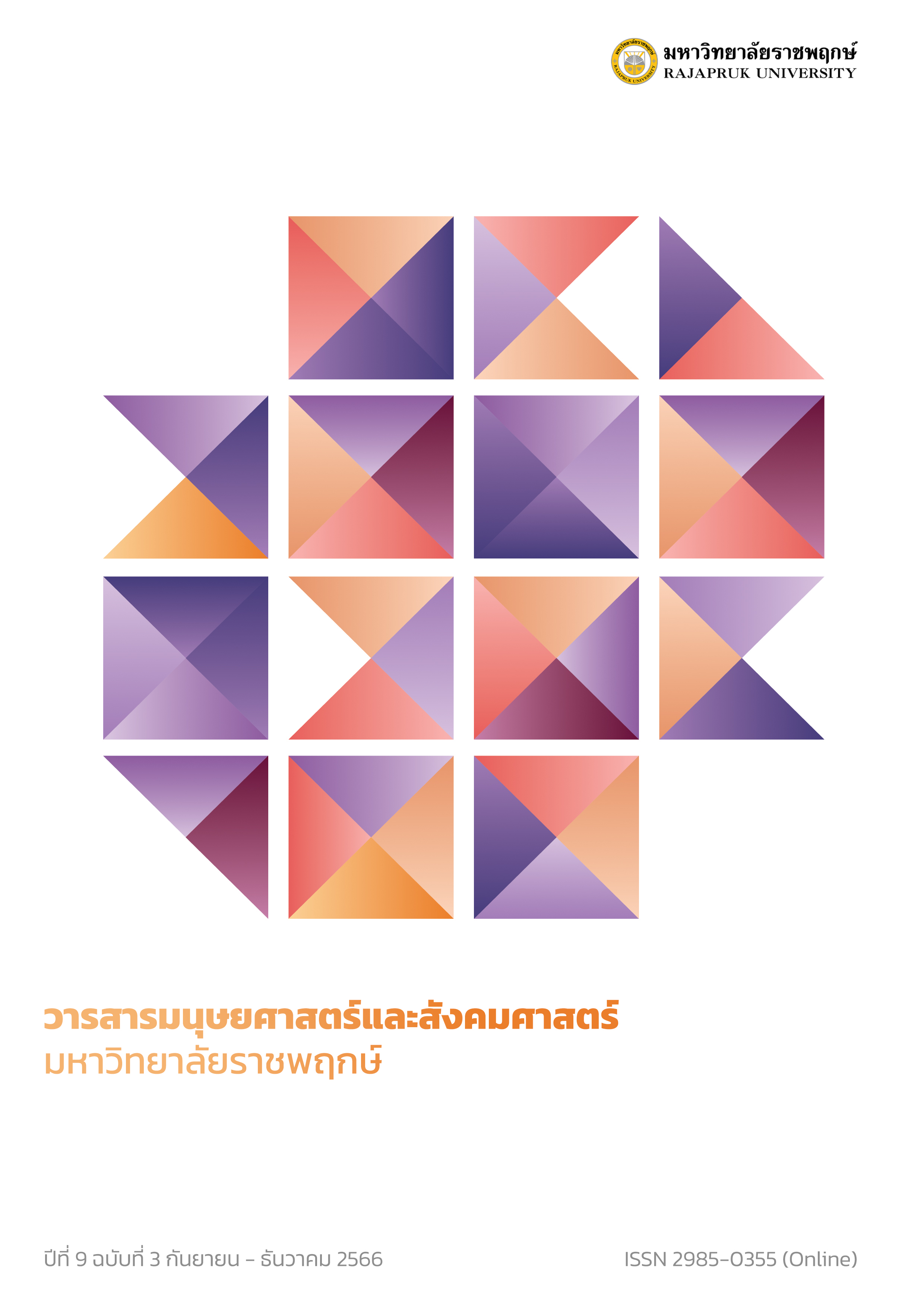Approach to Development of Local Economic Capital to Increase the Capacity of Community Enterprise Entrepreneurs in The Lower Northern Region of Thailand
Main Article Content
Abstract
The research objectives were to: 1) analyze the causal relationship paths influencing local economic capital, 2) create guidelines for the development of local economic capital, and 3) examine guidelines for the development of local economic capital to increase the capacity of community enterprise entrepreneurs in the lower northern region of Thailand. The sample in this research was divided into 3 groups; the first was 360 people from community enterprises in the lower northern region of Thailand, the second was 5 key informants, and the third was 9 experts. Three types of research tools were used, comprising a questionnaire, a semi-structured interview form, and an assessment form. The data were analyzed using statistical techniques, structural equation modeling, mean, standard deviation, and content analysis. The results showed that 1) The causal correlation path analysis model was fairly consistent with the empirical data, considering the Chi-square Probability Level of 161.389, Relative Chi-square of 1.416, Goodness of Fit Index of .956, and Root Mean Square Error of Approximation of .026. 2) The development of local economic capital had a causal relationship with increasing competitiveness. As for the strategy of marketing mix and social capital, there was a direct causal relationship with local economic capital, and there was an indirect causal relationship with increased competitiveness transmitted through local economic capital. and 3) The guidelines in terms of the aspects of accuracy, appropriateness, feasibility, and usefulness overall were at the highest average level.
Article Details
References
กริช แรงสูงเนิน. (2554). การวิเคราะห์ปัจจัยด้วย SPSS และ AMOS เพื่อการวิจัย. กรุงเทพฯ: ซีเอ็ดยูเคชั่น.
กัลยา วานิชย์บัญชา. (2560). สถิติสำหรับงานวิจัย: หลักการเลือกใช้เทคนิคทางสถิติในงานวิจัยพร้อมทั้งอธิบายผลลัพธ์ที่ได้จาก SPSS. พิมพ์ครั้งที่ 11. กรุงเทพฯ: สามลดา.
ดนชนก เบื่อนอย. (2559). นวัตกรรมกับความคิดสร้างสรรค์. วารสารวิชาการการตลาดและการจัดการ มหาวิทยาลัยเทคโนโลยีราชมงคลธัญบุรี, 3(1): 1-12.
ตวงทอง ลาภเจริญทรัพย์. (2563). ปัจจัยที่มีอิทธิพลต่อประสบการณ์ของนักท่องเที่ยวที่มีผลต่อคุณค่าของจุดหมายปลายทางของนักท่องเที่ยวชาวต่างชาติในประเทศไทย. วารสารรามคำแหง ฉบับบัณฑิตวิทยาลัย, 3(2): 59-75.
ศรายุทธ รัตนปัญญา. (2559). การพัฒนารูปแบบการประเมินสมรรถนะโดยประยุกต์ใช้การประเมินแบบเสริมพลังอำนาจสำหรับผู้บริหารสถานศึกษาใหม่ สังกัดสำนักงานคณะกรรมการการศึกษาขั้นพื้นฐาน. วารสารบัณฑิตศึกษา มหาวิทยาลัยราชภัฏสกลนคร, 13(60): 201-212.
สำนักงานเลขานุการคณะกรรมการส่งเสริมวิสาหกิจชุมชน. (2564). คู่มือการประเมินศักยภาพวิสาหกิจชุมชน. ค้นเมื่อวันที่ 11 มีนาคม 2565, จาก http://smce.doae.go.th/.
สุธีรา อะทะวงษา. (2557). คุณลักษณะของการเป็นผู้ประกอบการ และลักษณะของสถานประกอบการที่มีผลต่อการเจริญเติบโตของวิสาหกิจขนาดกลางและขนาดย่อมของประเทศไทย. วิทยานิพนธ์ ปริญญาดุษฎีบัณฑิต มหาวิทยาลัยธุรกิจบัณฑิตย์.
Cai, L. A. (2002). Cooperative branding for rural destination. Annals of Tourism Research, 29(3): 720-742.
Cronbach, Lee J. (2001). Essentials of psychological testing. 5th ed. New York: Harper Collins.
Crossan, M. M., & Apaydin, M. (2010). A Multi-Dimensional Framework of Organizational Innovation: A Systematic Review of the Literature. Journal of Management Studies, 47: 1154-1191.
Dess, Gregory G., Lumpkin G.T. and Eisner Alan B. (2007). Strategic management: Text & Case. 3rd ed. Boston: McGraw-Hill.
Dworkin, S. L. (2012). Sample size policy for qualitative studies using in-depth interviews. Archives of Sexual Behavior, 41(6), 1319-1320. doi:10.1007/s10508- 012-0016-6
Fusch, P. I., & Ness, L. R. (2015). Are We There Yet? Data Saturation in Qualitative Research. The Qualitative Report, 20(9): 1408-1416.
Guest, G., Bunce, A., & Johnson, L. (2006). How many interviews are enough? An experiment with Data Saturation and variability. Field Methods, 18(1): 59-82.
Hair, J. F., Black, W. C., Babin, B. J., & Anderson, R. E. (2010). Multivariate data analysis: A global perspectives. Upper Saddle River, NJ: Pearson Education, International.
Im, H. H., Kim, S. S., Elliot, S., & Han, H. (2012). Conceptualizing destination brand equity dimensions from a customer–based brand equity perspective. Journal of Travel & Tourism Marketing, 29: 385–403.
Kapferer J.N. (2005). The post-global brand. Journal of Brand Management, 12(5): 319-324.
Konecnik, M., & Gartner, C. W. (2007). Customer-based brand equity for a destination. Annals of Tourism Research, 34(2): 400-421.
McKeen, James D.,& Smith, Heather A. (2003). Making IT Happen: Critical Issues in IT Management. Ontario: Wiley.
McMillan, J.H., & Schumacher. (2001). Research in Education. 5th ed. New York: Addison Wesley Longman, Inc.
Onwuegbuzie, A. J., & Leech, N. L. (2007). A Call for Qualitative Power Analyses. Quality and Quantity, 41, 105-121.
Porter, M. E. (1990). The Competitive Advantage of Nations. London: Macmillan.
Ritchie, J. R. B., & Crouch, G. I. (2003). The competitive destination: A Sustainable Tourism Perspective. Wallingford, United Kingdom: CABI.
Robert A. Baron and Jintong Tang. (2011). The role of entrepreneurs in firm-level innovation: Joint effects of positive affect, creativity and environmental dynamism. Journal of Business Venturing, 26: 49-60.


